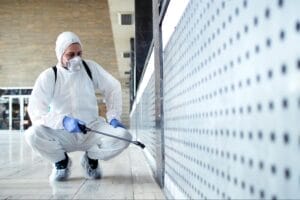When faced with mold issues, mold remediation becomes essential to safeguard your health and property. On average, mold remediation costs range between $1,500 and $3,000, depending on the extent and location of the mold infestation.
Signs You May Need Mold Remediation Service
Identifying early signs of mold can prevent extensive damage and health risks:
- Mold Odor: A musty or moldy smell in certain areas of the home indicates active mold growth. This odor is often the first noticeable sign of a mold problem.
- Dark-Colored Spots: Visible mold growth on walls, ceilings, or other surfaces. Mold can appear in various colors, including black, green, or brown spots, indicating different types of mold.
- Water Damage: Previous leaks, flooding, or water intrusion that was not properly dried or remediated can lead to mold growth. Areas affected by water damage are prone to mold unless properly treated.
- Condensation: Excessive moisture buildup, especially in areas with poor ventilation such as bathrooms, kitchens, or basements. Condensation can create ideal conditions for mold growth on surfaces.
- Allergic Reactions: Symptoms like sneezing, coughing, itchy eyes, or skin irritation that worsen when spending time indoors. Mold spores released into the air can trigger allergic reactions in sensitive individuals.

Why You Need A Mold Remediation Professional
Attempting mold remediation without professional assistance can be risky and ineffective. Here’s why hiring a professional is crucial:
- Expertise: Professionals have specialized training and experience in identifying mold types, assessing the extent of mold damage, and implementing effective remediation strategies.
- Safe Removal: Proper containment and removal techniques are essential to prevent the spread of mold spores to unaffected areas of the home. Professionals use advanced equipment and techniques to ensure safe and thorough mold removal.
- Prevention of Health Risks: Mold remediation professionals mitigate health risks associated with mold exposure. They wear protective gear and use appropriate cleaning solutions to minimize exposure to mold spores and mycotoxins.
- Thorough Cleanup: After removing mold, professionals clean and disinfect affected areas to prevent mold recurrence. They also address underlying moisture issues to eliminate the conditions that promote mold growth.
Can You Do Mold Remediation Yourself?
While DIY mold removal methods exist, they are suitable only for small, localized mold problems. DIY methods like cleaning with vinegar or hydrogen peroxide may be effective for minor surface mold on non-porous materials. Improper handling of mold can lead to cross-contamination and health risks.
Professionals ensure thorough containment and safe removal of mold, Hence, consulting a mold remediation professional is recommended for accurate assessment and safe removal of mold, especially in cases of significant mold infestation or potential health concerns.
Can Mold Grow Back After Remediation?
Mold can regrow if the underlying moisture problem is not resolved. Here’s why:
- Mold spores are present everywhere in the environment, and they can remain dormant until conditions are favorable for growth.
- Effective mold remediation includes identifying and addressing sources of moisture, such as leaks, humidity, or poor ventilation.
Professionals use moisture meters and thermal imaging to detect hidden moisture and ensure thorough drying and prevention of mold recurrence. Regular inspections and maintenance can help prevent mold growth by addressing moisture issues promptly and maintaining proper ventilation and humidity levels in your home.
What to Spray to Prevent Mold After Water Damage
After experiencing water damage, it’s crucial to take immediate action to prevent mold growth and remove the standing water and moisture sources promptly. Use fans and dehumidifiers to dry out affected areas. For more detailed information on preventing mold after water damage, refer to our comprehensive guide on What to Spray to Prevent Mold After Water Damage.




